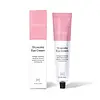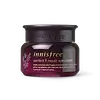What's inside
What's inside
 Key Ingredients
Key Ingredients

 Benefits
Benefits

 Concerns
Concerns

 Ingredients Side-by-side
Ingredients Side-by-side

Water
Skin ConditioningCoco-Caprylate
EmollientUrea
BufferingGlyceryl Stearate
EmollientBacillus Ferment
Skin ConditioningCetyl Alcohol
EmollientDalea Spinosa Seed Oil
MaskingTocopherol
AntioxidantPolyglyceryl-6 Stearate
EmollientStearic Acid
CleansingSimmondsia Chinensis Seed Oil
EmollientOryza Sativa Bran Oil
EmollientHexylresorcinol
AntimicrobialGlycerin
HumectantSodium Anisate
AntimicrobialSodium Levulinate
Skin ConditioningSodium Ascorbyl Phosphate
AntioxidantLactic Acid
BufferingGlyceryl Caprylate
EmollientPolyglyceryl-6 Behenate
Emulsion StabilisingGellan Gum
Ferulic Acid
AntimicrobialGlycyrrhiza Glabra Root Extract
BleachingSodium Phytate
Chamomilla Recutita Flower Extract
MaskingXanthan Gum
EmulsifyingCitric Acid
BufferingPotassium Sorbate
PreservativeWater, Coco-Caprylate, Urea, Glyceryl Stearate, Bacillus Ferment, Cetyl Alcohol, Dalea Spinosa Seed Oil, Tocopherol, Polyglyceryl-6 Stearate, Stearic Acid, Simmondsia Chinensis Seed Oil, Oryza Sativa Bran Oil, Hexylresorcinol, Glycerin, Sodium Anisate, Sodium Levulinate, Sodium Ascorbyl Phosphate, Lactic Acid, Glyceryl Caprylate, Polyglyceryl-6 Behenate, Gellan Gum, Ferulic Acid, Glycyrrhiza Glabra Root Extract, Sodium Phytate, Chamomilla Recutita Flower Extract, Xanthan Gum, Citric Acid, Potassium Sorbate
Water
Skin ConditioningButylene Glycol
HumectantGlycerin
HumectantHydrogenated Polyisobutene
EmollientPentaerythrityl Tetraethylhexanoate
EmollientCetearyl Alcohol
EmollientNiacinamide
SmoothingCyclopentasiloxane
EmollientDimethicone
EmollientGlyceryl Stearate
EmollientCyclohexasiloxane
EmollientSqualane
EmollientPolymethyl Methacrylate
Cetyl Ethylhexanoate
EmollientButyrospermum Parkii Butter
Skin Conditioning1,2-Hexanediol
Skin ConditioningStearic Acid
CleansingPEG-100 Stearate
Copernicia Cerifera Wax
Pentaerythrityl Distearate
EmulsifyingPalmitic Acid
EmollientPolyacrylate-13
Caprylic/Capric Triglyceride
MaskingBehenyl Alcohol
EmollientCaffeine
Skin ConditioningCetearyl Glucoside
EmulsifyingDimethicone/Vinyl Dimethicone Crosspolymer
Skin ConditioningPolyglyceryl-10 Pentastearate
Skin ConditioningPolyisobutene
Parfum
MaskingPropanediol
SolventGlyceryl Caprylate
EmollientSodium Stearoyl Lactylate
EmulsifyingEthylhexylglycerin
Skin ConditioningDisodium EDTA
Adenosine
Skin ConditioningPolysorbate 20
EmulsifyingSorbitan Isostearate
EmulsifyingHydrogenated Lecithin
EmulsifyingDextrin
AbsorbentTheobroma Cacao Extract
Skin ConditioningBeta-Glucan
Skin ConditioningCaprylyl Glycol
EmollientArtemisia Vulgaris Extract
Skin ConditioningHouttuynia Cordata Extract
Skin ConditioningRubus Idaeus Fruit Extract
AstringentPrunella Vulgaris Leaf Extract
Skin ConditioningLonicera Japonica Flower Extract
Skin ConditioningZanthoxylum Piperitum Fruit Extract
Skin ConditioningTaraxacum Officinale Rhizome/Root Extract
Skin ConditioningGanoderma Lucidum Extract
Skin ProtectingGlucose
HumectantMyristic Acid
CleansingArachidic Acid
CleansingTocopherol
AntioxidantSparassis Crispa Extract
Emulsion StabilisingWater, Butylene Glycol, Glycerin, Hydrogenated Polyisobutene, Pentaerythrityl Tetraethylhexanoate, Cetearyl Alcohol, Niacinamide, Cyclopentasiloxane, Dimethicone, Glyceryl Stearate, Cyclohexasiloxane, Squalane, Polymethyl Methacrylate, Cetyl Ethylhexanoate, Butyrospermum Parkii Butter, 1,2-Hexanediol, Stearic Acid, PEG-100 Stearate, Copernicia Cerifera Wax, Pentaerythrityl Distearate, Palmitic Acid, Polyacrylate-13, Caprylic/Capric Triglyceride, Behenyl Alcohol, Caffeine, Cetearyl Glucoside, Dimethicone/Vinyl Dimethicone Crosspolymer, Polyglyceryl-10 Pentastearate, Polyisobutene, Parfum, Propanediol, Glyceryl Caprylate, Sodium Stearoyl Lactylate, Ethylhexylglycerin, Disodium EDTA, Adenosine, Polysorbate 20, Sorbitan Isostearate, Hydrogenated Lecithin, Dextrin, Theobroma Cacao Extract, Beta-Glucan, Caprylyl Glycol, Artemisia Vulgaris Extract, Houttuynia Cordata Extract, Rubus Idaeus Fruit Extract, Prunella Vulgaris Leaf Extract, Lonicera Japonica Flower Extract, Zanthoxylum Piperitum Fruit Extract, Taraxacum Officinale Rhizome/Root Extract, Ganoderma Lucidum Extract, Glucose, Myristic Acid, Arachidic Acid, Tocopherol, Sparassis Crispa Extract
 Reviews
Reviews

Ingredients Explained
These ingredients are found in both products.
Ingredients higher up in an ingredient list are typically present in a larger amount.
Glycerin is already naturally found in your skin. It helps moisturize and protect your skin.
A study from 2016 found glycerin to be more effective as a humectant than AHAs and hyaluronic acid.
As a humectant, it helps the skin stay hydrated by pulling moisture to your skin. The low molecular weight of glycerin allows it to pull moisture into the deeper layers of your skin.
Hydrated skin improves your skin barrier; Your skin barrier helps protect against irritants and bacteria.
Glycerin has also been found to have antimicrobial and antiviral properties. Due to these properties, glycerin is often used in wound and burn treatments.
In cosmetics, glycerin is usually derived from plants such as soybean or palm. However, it can also be sourced from animals, such as tallow or animal fat.
This ingredient is organic, colorless, odorless, and non-toxic.
Glycerin is the name for this ingredient in American English. British English uses Glycerol/Glycerine.
Learn more about GlycerinGlyceryl Caprylate comes from glycerin and caprylic acid, a fatty acid from coconut. It has emollient and emulsifier properties.
As an emollient, it helps hydrate your skin. Emollients work by creating a barrier on your skin to trap moisture in, helping to keep your skin soft and smooth.
On the other hand, emulsifiers prevent ingredients (such as oil and water) from separating.
Learn more about Glyceryl CaprylateGlyceryl Stearate is a mix of glycerin and stearic acid.
It is used to stabilize the mixing of water and oil ingredients. By preventing these ingredients from separating, it can help elongate shelf life. It can also help thicken the product's texture.
As an emollient, it helps soften skin and supports barrier-replenishing ingredients.
In cosmetics, Glyceryl Stearate is often made from vegetable oils or synthetically produced.
This ingredient may not be fungal-acne safe
Fun fact: The human body also creates Glyceryl Stearate naturally.
Learn more about Glyceryl StearateStearic Acid is a fatty acid. It is an emollient, emulsifier, and texture enhancer.
As an emollient, stearic acid helps soften skin. It aids the skin's protective barrier by preventing water loss. It also provides a gentle cleansing effect without stripping away natural oils.
Stearic acid may also be used to enhance the texture of products. It can add volume and stabilize ingredients such as water and oil. This can help water and oil ingredients from separating.
Sources of stearic acid include animal or vegetable fats/oils such as coconut or shea. It can be naturally found in butter, cocoa butter, shea butter, vegetable fats, and animal tallow.
This ingredient may not be Malassezia folliculitis, or fungal-acne safe.
Learn more about Stearic AcidTocopherol (also known as Vitamin E) is a common antioxidant used to help protect the skin from free-radicals and strengthen the skin barrier. It's also fat soluble - this means our skin is great at absorbing it.
Vitamin E also helps keep your natural skin lipids healthy. Your lipid skin barrier naturally consists of lipids, ceramides, and fatty acids. Vitamin E offers extra protection for your skin’s lipid barrier, keeping your skin healthy and nourished.
Another benefit is a bit of UV protection. Vitamin E helps reduce the damage caused by UVB rays. (It should not replace your sunscreen). Combining it with Vitamin C can decrease sunburned cells and hyperpigmentation after UV exposure.
You might have noticed Vitamin E + C often paired together. This is because it is great at stabilizing Vitamin C. Using the two together helps increase the effectiveness of both ingredients.
There are often claims that Vitamin E can reduce/prevent scarring, but these claims haven't been confirmed by scientific research.
Learn more about TocopherolWater. It's the most common cosmetic ingredient of all. You'll usually see it at the top of ingredient lists, meaning that it makes up the largest part of the product.
So why is it so popular? Water most often acts as a solvent - this means that it helps dissolve other ingredients into the formulation.
You'll also recognize water as that liquid we all need to stay alive. If you see this, drink a glass of water. Stay hydrated!
Learn more about Water